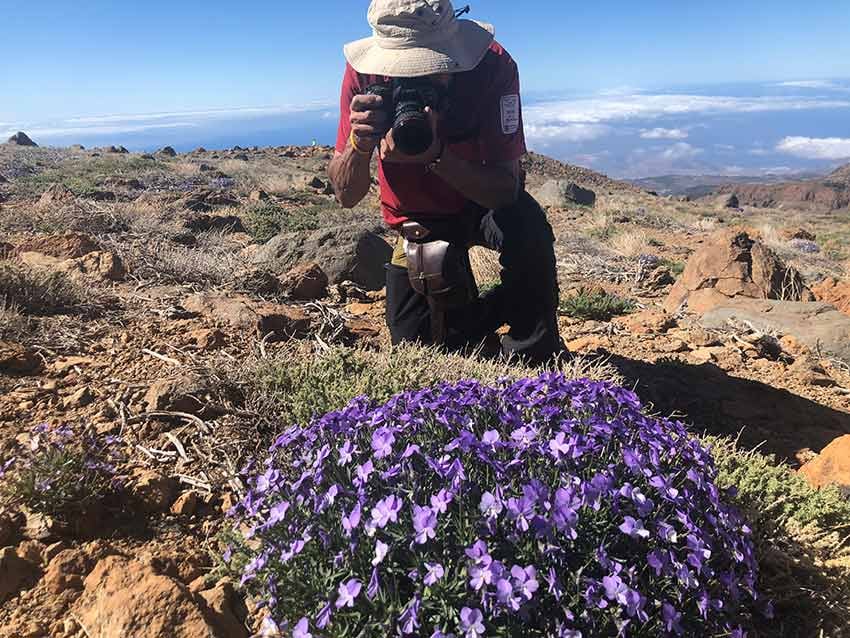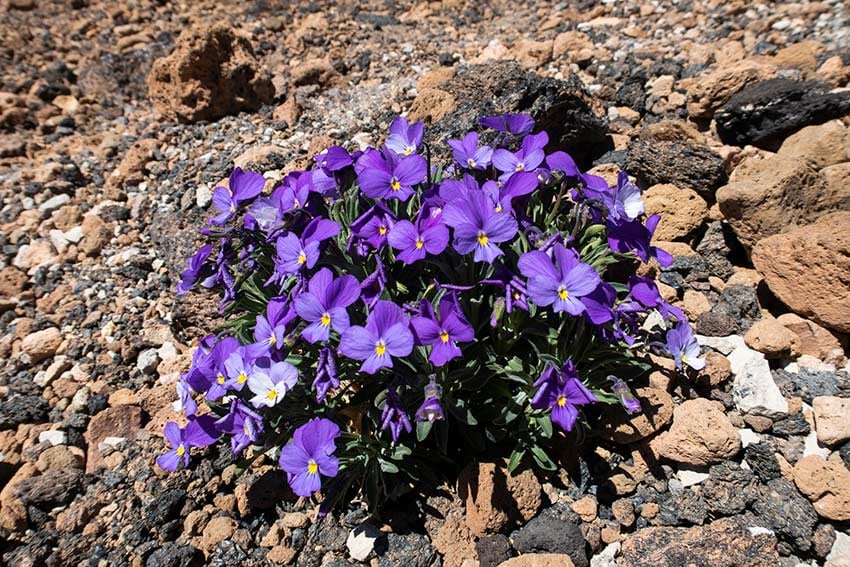The Guajara violet is another gem found among the unique flora of Teide National Park.
INDEX
There is still much to discover in Teide National Park
You might think that, being Europe’s most visited national park, there was no longer anything new left to discover in Teide National Park.
And yet, thanks to extensive and continuous scientific research, hardly a year goes by without the discovery of a new type of plant or animal, the unearthing of another archaeological site or the revealing analysis of an unusual geological formation.
A truly surprising find among all these discoveries was made recently when a new species of violet was catalogued and added to the long list of flora that is only found in Teide National Park.
Naturally, the island’s old goat herders and mountain dwellers knew about a small population of “slightly odd” violets on the south side of Mount Guajara, but it wasn’t until recently that they were identified as having a different shape and genetic make-up to the famous Teide violets that grow up to the volcano’s peak.
This means that Teide National Park has not just one but two endemic species of violet among its flora.

What is an endemic species and why are there so many in Teide National Park?
An endemic plant or animal species means that it belongs to and is exclusively found in one place.
For example, yellow-legged gulls are native to the Canary Islands because no-one brought them here, they arrived under their own steam. But they are also found in lots of other places around the world.
In contrast, the laurel pigeon and Bolle’s pigeon are endemic to the forests of Tenerife, Gran Canaria, La Palma, La Gomera and El Hierro. The ancestors of these pigeons came to the islands and evolved here until they became a different species, and they aren’t found anywhere else on Earth.
The area inhabited by an endemic species can vary in size and can be anything from a region to a mountain or cave. The smaller the habitat, the more vulnerable the species. Any changes to its home could set it on a path to extinction because there are no reserve populations anywhere else.
Both the Teide violet and the Guajara violet grow in very small areas in the high mountain zones of Tenerife.

These two flowers of Teide, the Teide and Guajara violets, are just two examples of the incredible lineage of unique species that inhabit the national park.
There are seventeen exclusive plant species and over a hundred endemic invertebrates including spiders, beetles, flies, aphids and bees whose characteristics make them different from those found anywhere else on the planet. And new ones are being found all the time!
This wealth and variety of plant and animals that live in Teide National Park evolved to adapt to very specific and demanding conditions for life. These species are capable of surviving extreme temperature differences between day and night, extremely low humidity with many hours of sunshine, winds that are often strong and gusty, fairly infertile volcanic soil and as little rainfall as a desert. And even so, or rather, because of all this, Teide is a flourishing garden full of incredible species.
As they said in Jurassic Park: “life finds a way”.
The discovery of the Guajara violet
The Teide violet is the most famous sibling of the five endemic violets that grow in the Canary Islands.
This floral specimen from Teide National Park was first mentioned by botanist and astronomer Louis Feuillé at the beginning of the 18th century when he climbed Mount Teide on one of the first serious attempts to measure the volcano’s height.
At the end of 18th century, none other than Alexander von Humboldt named it in the chapter on Tenerife in his book Journey to the Equatorial Regions of the New Continent and he gave it its scientific name: Viola cheiranthyfolia.
The Teide violet has the record for being the flower that grows at the highest altitude in Spain, and it can even be found at an altitude of 3,700 m.
Viola guaxarensis or the Guajara violet grows around a thousand metres lower down and seven kilometres away as the crow flies.
However, it wasn’t until 2020 that work by biologists Manuel Marrero, José Luis Martín Esquivel, José Docoito and Manuel Suárez was published proving that the Guajara violet was a different species.
And now another small violet has joined the podium alongside the most endangered plant species in the world.
To ensure it endures, fencing was installed a few years ago to prevent herbivores that have been introduced into the park (mouflons and rabbits) from putting an end to this tiny surviving population. But the threat of climate change also hangs over its head.
The Teide and Guajara violets: two high mountain dwellers
Violets are seemingly fragile plants that don’t look as though they would be able to withstand severe weather systems.
And yet the Guajara and Teide violets grow in the extreme conditions at the peaks of Mount Teide and Mount Guajara to share their beautiful lilac flowers with us each spring.
Visit El Portillo Botanical Gardens to admire both species of plant from Teide National Park and spot the subtle differences between the shapes of their leaves and flowers. The botanical garden is working hard to conserve both species by gathering their seeds to grow more plants.
Article by María Mengual, an authority and reporter on our heritage. With thanks to José Luis Martín Esquivel, coordinator for the Conservation Area at Teide National Park, for his suggestions to improve the accuracy of this content.

















